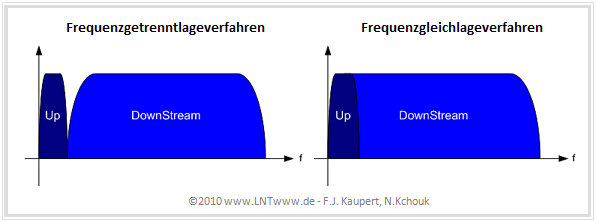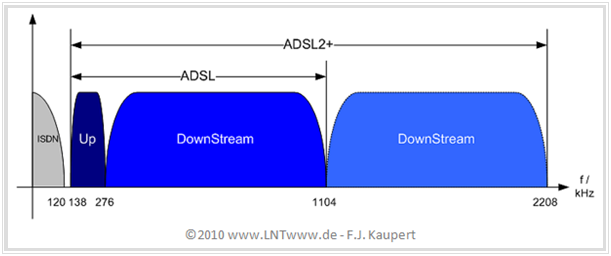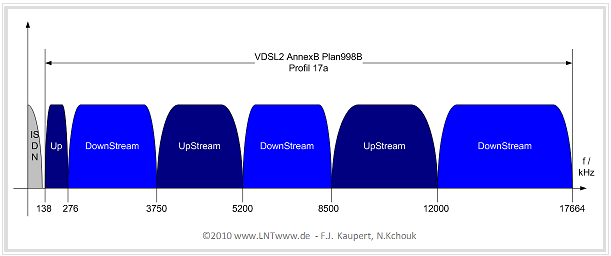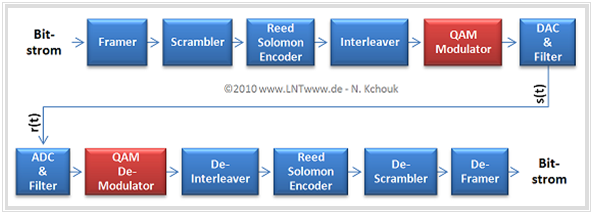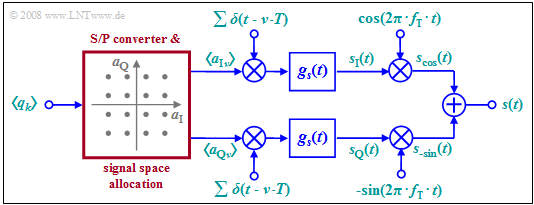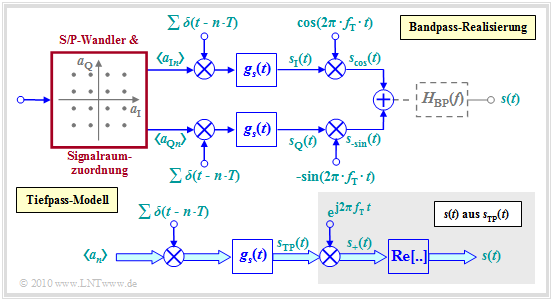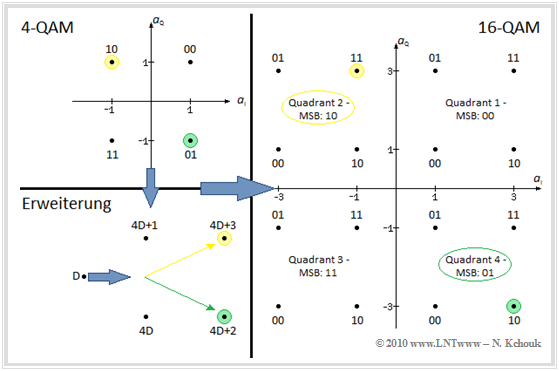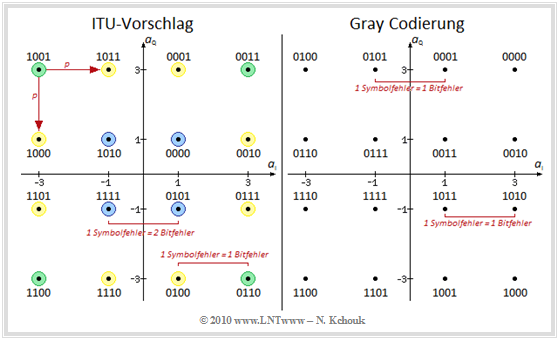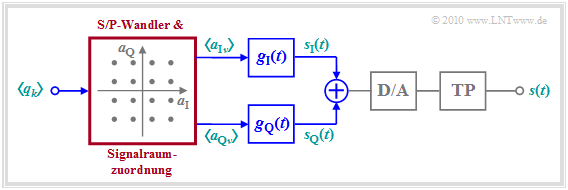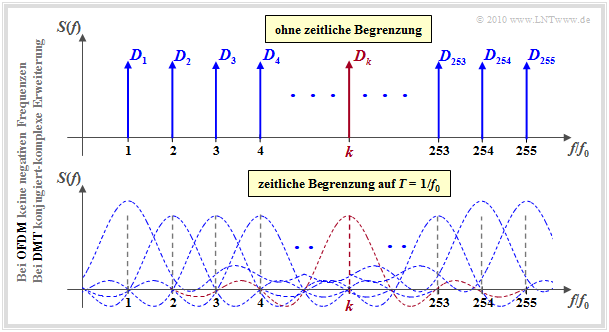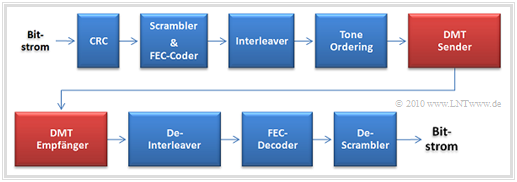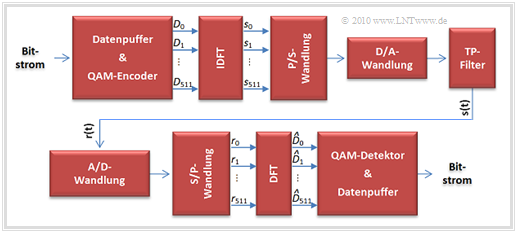Contents
- 1 Possible bandwidth allocations for xDSL
- 2 ADSL bandwidth allocation in Germany
- 3 VDSL(2) bandwidth allocation
- 4 Overview of transmission methods
- 5 Basics of Quadrature Amplitude Modulation
- 6 Possible QAM signal space constellations
- 7 Carrierless Amplitude Phase Modulation (CAP)
- 8 Basics of DMT - Discrete Multitone Transmission
- 9 DMT–Realisierung mit IDFT/DFT
- 10 Aufgaben zum Kapitel
Possible bandwidth allocations for xDSL
The xDSL specifications give operators a great deal of freedom with regard to allocation.
For the necessary directional separation of the xDSL signal transmission according to
- downstream direction from the provider to the customer (downstream with the highest possible data rate),
- upstream direction from the customer to the provider (upstream with mostly lower data rate)
two variants have been standardized for this purpose:
$\text{Definition:}$
- In the Frequenzgetrenntlageverfahren the data streams for the two directions are transmitted in two separate frequency bands with the advantage that a simple filter is sufficient to separate the transmission directions, which simplifies the technical implementation.
- In the Frequenzgleichlageverfahren the spectra of upstream and downstream overlap in a certain part. The separation is done here with the help of an echo cancellation circuit. Advantages of the method are the lower bandwidth requirement at higher (and thus more attenuated) frequencies, as well as a longer range.
The graphic compares these two options.
Basically, the specifications leave it up to the developers/operators to decide,
- to operate xDSL alone on the subscriber line, or
- to allow mixed operation of xDSL with the telephone services POTS (Plain Old Telephone Service) or ISDN (Integrated Services Digital Network) ,
- and thus to exclude or also occupy the lower frequency range occupied by the two telephone services for xDSL.
ADSL bandwidth allocation in Germany
Because it is technically much easier to implement, the decision was made in favor of ADSL and ADSL2+ in Germany.
- of the Frequenzgetrenntlageverfahren,
- the general reservation of the lower frequency range for ISDN.
The Frequenzgleichlageverfahren is still used in some cases, but rather rarely.
For the transmission methods
the bandwidth available for DSL is not further decomposed.
In contrast, in the multicarrier method "DMT" (Discrete Multitone Transmission), the uplink channel and the downlink channel are divided into $N_{\rm Up}$ respectively. $N_{\rm Down}$ bins of 4.3125 kHz each.
In addition to the above graph, it should be noted:
- Phone services (POTS or ISDN) and xDSL are in different frequency bands, which minimizes mutual interference in the trunk cable. Thus, the stronger signal ISDN does not interfere with the parallel running xDSL and vice versa.
- The lower frequency range up to $\text{120 kHz}$ has been reserved for ISDN (optionally POTS). This value results from the first zero of the "ISDN spectrum with 4B3T coding". Above $\text{120 kHz}$ the ISDN spectrum is completely suppressed.
- To separate the telephone and xDSL signals, a "splitter" is used at both ends of the two-wire line, which includes one low-pass filter and one high-pass filter each and also takes into account the following frequency gap up to $\text{138 kHz}$ .
- After this occupancy gap follows the ADSL upstream band from $\text{138 kHz}$ to $\text{276 kHz}$. This bandwidth allows the transmission of $N_{\rm Up} = 32$ subcarriers at $\text{4.3125 kHz}$ each. This value is derived from the frame transmission rate.
- The subsequent downstream range extends to $\text{1104 kHz}$ for ADSL, with which $N_{\rm Down} = 256$ subcarriers can be realized. The separation of up and down channel in xDSL is done by a band-pass filter in the modem.
- However, the first $64$ subcarriers $($this corresponds to $\text{276 kHz)}$ must not be occupied. With "Frequenzgleichlageverfahren" only $32$ subcarriers would have to be left out, taking into account that the separation of uplink and downlink requires a more complex implementation.
- For ADSL2+, the system bandwidth is equal to $\text{2208 kHz}$ ⇒ $N_{\rm Down} = 512$ subcarriers. The number of bins to be spared remains unchanged compared to ADSL. Taking into account that two bins are occupied by control functions (e.g. for synchronization of transmitter and receiver), $190$ (ADSL) or $446$ (ADSL2+) downstream channels remain for users.
- The ISDN reservation prescribed in Germany, however, has the consequence for xDSL that the low frequencies, which are by far the least attenuated in a copper line and would therefore actually be the most suitable, cannot be used.
- Further, from the frequency arrangement, it can be seen that the downstream bins are more attenuated than the upstream bins (higher frequencies) and consequently have a smaller signal-to-noise ratio (SNR).
- The decision "upstream below downstream" is related to the fact that the loss of downstream channels has only a comparatively small impact on the transmission rate. In the upstream, such a failure would be much more noticeable in percentage terms.
VDSL(2) bandwidth allocation
The ITU has defined several profiles for VDSL(2). At the time of writing this chapter (2010), the frequency band assignment specified in the graphic applies to the systems deployed in Germany in accordance with the ITU's VDSL(2) Plan 998b - Profile 17a (Annex B). The (slightly) lighter coloring at the higher frequencies is meant to indicate that these channels are more attenuated.
Without claiming to be exhaustive, this allocation plan can be characterized as follows:
- To achieve higher bit rates, eight times as many bins are used here as in ADSL2+. Thus, the system bandwidth is $8 - \text{2208 MHz = 17664 MHz}$, enabling transmission rates of up to $\text{100 Mbit/s}$ (depending on cable length and condition).
- Also here, the frequency bands for the upstream subchannels are always arranged at the lower frequencies, since the greater cable attenuation (increasing with frequency) has a greater percentage influence on the total bit rate for upstream than for downstream.
- In VDSL(2) systems, the so-called "Frequenzgetrenntlageverfahren" is always used. Overlapping of the upstream and downstream frequency bands is categorically excluded in the ITU specification for VDSL(2).
- In the VDSL systems in Germany, the lower frequencies are again reserved for ISDN. This is followed by alternating ranges for upstream and downstream. From the specified range limits, one can recognize the upstream ranges, which are narrower than the downstream.
- You can see an alternating arrangement of upstream and downstream areas. One reason for this is that with this wide spectrum it should be avoided that one direction (for example downstream) is assigned only strongly attenuated (i.e. high) frequencies.
- The VDSL(2) specification provides for allocation plans up to system bandwidths of $\text{30 MHz}$ (according to profile 30a), which should enable transmission rates up to about $\text{ 200 Mbit/s}$ over short distances. For this purpose, the bandwidth of the individual subchannels is also doubled compared to ADSL to $\text{8.625 kHz}$ .
- All occupancy plans are provided with different masks for the power density spectrum in order to limit the maximum transmit power and thus the interference to neighboring systems in the cable bundle (crosstalk).
Overview of transmission methods
At the beginning of the various standardization procedures for the individual xDSL variants, different transmission methods were defined as a basis:
- "Pulse Code Modulation (PCM)" for ISDN as well as Trellis Coded-Pulse Amplitude Modulation for HDSL2 and SHDSL/SDSL,
- "Quadrature Amplitude Modulation (QAM)" for QAM-ADSL and QAM-VDSL,
- "Carrierless Amplitude Phase Modulation (CAP)" for CAP-HDSL and CAP-ADSL,
- "Discrete Multitone Transmission (DMT)" for ADSL, ADSL2, ADSL 2+, VDSL and VDSL2.
With increasing market demand for higher transmission rates and the associated requirements, two main suitable processes crystallized, namely $\rm QAM/CAP$ and $\rm DMT$.
Since the manufacturers were unable to agree on a common standard from 1997 to 2003, also for patent reasons (one even speaks of line code wars in this context), the two competing methods coexisted for a long time. At the so-called DSL Olympics in 2003, the decision was finally made in favor of DMT,
- on the one hand because of the slightly better "performance" in general,
- but in particular because of its higher robustness against narrowband interference.
Especially for the USA (many overhead telephone lines and related problems with coupled radio signals) the second argument played a major role.
The xDSL variants ADSL2(+) and VDSL(2), which are predominantly offered in Germany today (2010), are all based on the Discrete Multitone Transmission method, although the individual subcarriers may well be occupied by QAM signals.
First, however, the systems $\rm xDSL-QAM$ and $\rm xDSL-CAP$ will be considered very briefly.
Basics of Quadrature Amplitude Modulation
The diagram shows the reference model for ADSL-QAM, and here we will only deal with the red function blocks QAM modulator and QAM demodulator .
The carrier frequency $f_{\rm T}$ is in each case within the specified uplink and downlink band of the respective xDSL variant. Like the signal space size (between four and 256 signal space points) and the symbol rate, it is determined by channel measurements during initialization of the transmission.
For ADSL QAM, the following symbol rates $($in ${\rm kBaud} = 1000 \rm symbols/s)$ have been specified:
- $20$, $40$, $84$, $100$, $120$, $136$ upstream,
- $40$, $126$, $160$, $252$, $336$, $504$, $806.4$, $1008$ in the downstream.
The principle has already been described in detail in the chapter "Quadrature Amplitude Modation" of the book "Modulation Methods".
Here follows only a short summary on the basis of the lower diagram.
- QAM is a single carrier modulation method around the carrier frequency $f_{\rm T}$. First, a blockwise serial/parallel conversion of the bit stream and signal space assignment is performed.
- From each $b$ binary symbol, two multilevel amplitude coefficients $a_{{\rm I}n}$ and $a_{{\rm Q}n}$ are derived (in-phase and quadrature components), where both coefficients can each take one of $M = 2^{b/2}$ possible amplitude values.
- The example considered in the graph applies to the $\text{16-QAM}$ with $b = M = 4$ and correspondingly $16$ signal space points. For a $\text{256-QAM}$ $b = 8$ and $M = 16$ would hold $(2^b = M^2 = 256)$.
- The coefficients $a_{{\rm I}n}$ and $a_{{\rm Q}n}$ are each impressed on a Dirac delta pulse as weights. For pulse shaping one usually uses (because of the small bandwidth) a raised-cosine filter. With the basic transmitted pulse $g_s(t)$ is then valid in the two branches of the block diagram:
- $$ s_{\rm I}(t) = \sum_{n = - \infty}^{+\infty}a_{\rm I\hspace{0.03cm}\it n} \cdot g_s (t - n \cdot T)\hspace{0.05cm},\hspace{0.5cm} s_{\rm Q}(t) = \sum_{n = - \infty}^{+\infty}a_{\rm Q\hspace{0.03cm}\it n} \cdot g_s (t - n \cdot T)\hspace{0.05cm}.$$
- Note also that because of the redundancy-free conversion to a higher-level code, the symbol duration $T$ of these signals is greater by a factor $b$ than the bit duration $T_{\rm B}$ of the binary input sequence. In the drawn example (16-QAM), $T = 4 - T_{\rm B}$.
- The QAM transmitting signal $s(t)$ is then the sum of the two partial signals multiplied by cosine and minus-sine, respectively (possibly followed by a band limit to prevent interference to adjacent bands, as indicated in the graph below):
- $$s(t) = s_{\rm I}(t) \cdot \cos (2 \pi f_{\rm T}\,t) - s_{\rm Q}(t) \cdot \sin (2 \pi f_{\rm T}\,t) \hspace{0.05cm}. $$
- The two branches $(\rm I$ and $\rm Q)$ can be considered as two completely separate $M$-level ASK systems which do not interfere with each other as long as all components are optimally designed.
- This means at the same time: Compared to a "Binary Phase Shift Keying" (BPSK: modulation with cosine or sine only), the quadrature amplitude modulation allows a doubling of the data rate at constant quality.
The last graph shows.
- above the band-pass model,
- below the equivalent low-pass model.
In this one, the inphase and quadrature coefficients are combined to give the complex amplitude coefficient
- $$a_n = a_{\text{I}n} + {\rm j} - a_{\text{Q}n}$$
and additionally replaces the C-signal $s(t)$ by the equivalent low-pass signal
- $$s_{\rm TP}(t) = s_{\rm I}(t) + {\rm j} - s_{\rm Q}(t).$$
The representation of the QAM transmitter and the QAM receiver is the content of the flash animation "Principle of Quadrature Amplitude Modulation".
$\text{Conclusion:}$
- As the number of bits $b$ and thus the number of defined symbols $(M^2)$ increases, the bandwidth efficiency increases, but the signal processing overhead also increases.
- In addition, it must be taken into account that a dense QAM allocation is appropriate only if the channel is sufficiently good
.
Possible QAM signal space constellations
We still consider possible arrangements of signal space points in quadrature amplitude modulation using three examples.
$\text{Example 1:}$ An important QAM parameter is the number of bits $b$ processed to the amplitude coefficient pair $(a_{\rm I}, a_{\rm Q})$ . Here $b$ is always even.
If $b = 2$, both $a_{\rm I}$ and $a_{\rm Q}$ can only take the values $±1$ resulting in the $\rm 4\hspace{0.05cm}–\hspace{-0.02cm}QAM$ corresponding to the left constellation.
According to an ITU recommendation, the assignment applies here:
- $$q_1 = 0, \ q_0 = 0 \, \Leftrightarrow \,a_{\rm I} = +1, \ a_{\rm Q} = +1,$$
- $$q_1 = 0, \ q_0 = 1 \, \Leftrightarrow \, a_{\rm I} = +1, \ a_{\rm Q} = -1,$$
- $$q_1 = 1, \ q_0 = 0 \, \Leftrightarrow \,a_{\rm I} = -1, \ a_{\rm Q} = +1,$$
- $$q_1 = 1, \ q_0 = 1 \, \Leftrightarrow \, a_{\rm I} = -1, \ a_{\rm Q} = -1.$$
The point marked in yellow 10 $(a_{\rm I} = -1, \ a_{\rm Q} = 1)$ thus stands for $q_1 = 1$ and $q_0 = 0$.
With $b = 4$ ⇒ $M = 2^{b/2} = 4$ one arrives at $\rm 16\hspace{0.05cm}–\hspace{-0.02cm}QAM$ according to the right diagram with the possible amplitude coefficients
- $$a_{\rm I} ∈ \{±3, ±1\}, \ \ a_{\rm Q} ∈ \{±3, ±1\}.$$
The assignment can be determined using the auxiliary graph given on the left below, as illustrated by the following numerical examples.
$\rm (A)$ $q_3 = 1, \ q_2 = 0, \ q_1 = 1,\ q_0 = 1$ (yellow marker):
- The two most significant bits (Most Significant Bit, MSB) 10 determine, according to the $\rm 4-QAM$ diagram, the quadrant in which the symbol is located.
- The two least significant bits (11) together with the auxiliary graph determine the point within the quadrant. The result is $a_{\rm I} = -1$, $a_{\rm Q} = +3$.
$\rm (B)$ $q_3 = 0, \ q_2 = 1, \ q_1 = 1,\ q_0 = 0$ (green mark):
- The two most significant bits (Most Significant Bit, MSB) 01 here refer to the fourth quadrant.
- The two least significant bits (10) refer to the green dot in the fourth quadrant: $a_{\rm I} = -3, \ a_{\rm Q} = -3$.
$\text{Example 2:}$
The decimal value $D$ provides another way to label the points.
- The yellow marked point in the $\rm 4\hspace{0.05cm}–\hspace{-0.02cm}QAM$ diagram is binary labeled 10 ⇒ decimal $D = 2$. This point simultaneously marks the quadrant of $\rm 16\hspace{0.05cm}–\hspace{-0.02cm}QAM$.
- The further subdivision results from the lower left graphic. There at the yellow dot $4D + 3$ ⇒ 11 (decimal) is written. Therefore, the upper right dot (highlighted in yellow) in the upper left quadrant stands for decimal $11$ ⇒ binary 1011.
- For the green dot, $D = 1$ gives the decimal value $4D + 2 ⇒ 6$, which corresponds to the binary representation 0110 .
According to this scheme, the signal space constellations for $\rm 64\hspace{0.05cm}–\hspace{-0. 02cm}QAM$ ⇒ $(b = 6, \ M = 8)$ and $\rm 256-QAM$ ⇒ $(b = 8, \ M = 16)$ which will be discussed in detail in the "Exercise 2.3"
$\text{Example 3:}$ We still consider for the described $\rm 16\hspace{0.05cm}–\hspace{-0.02cm}QAM$ (left graph, here referred to as ITU proposal) the resulting error probability in the presence of AWGN noise:
- An error can be assumed to result in a horizontally or vertically adjacent symbol, as indicated for the upper left (green) dot.
- The error probability $p$ depends on the Euclidean distance of the two points and the AWGN noise power density $N_0$ .
- A distortion to the more distant blue point instead of one of the two neighboring yellow points is rather unlikely with Gaussian noise.
All corner points (green background) can only be distorted in two directions. In contrast, the inner QAM points (blue background) have four direct neighbors and the remaining symbols (yellow background) have three. For the (average) symbol error probability then holds:
- $$p_{\rm S} = {1}/{16} \cdot (4 \cdot 2 p + 8 \cdot 3 p + 4 \cdot 4 p) = 3p.$$
To calculate the bit error probability $p_{\rm B}$ it must now be taken into account that for the left constellation a symbol error
- leads to only one bit error (example: 0100 ⇒ 0110, within one quadrant) or
- to two bit errors (example: 1111 ⇒ 0101, between adjacent quadrants).
The computation of $p_{\rm B} $ here involves some effort.
In contrast, in a Gray encoding (right diagram), each symbol differs from its neighbors by exactly one bit, and each symbol error thus results in exactly one bit error. Since each individual symbol contains four bits, the (average) bit error probability in this case is:
- $$p_{\rm B} = p_{\rm S}/4 = 3/4 \cdot p. $$
Carrierless Amplitude Phase Modulation (CAP)
Carrierless Amplitude Phase Modulation ('CAP) is a bandwidth-efficient variant of QAM, which can be realized very easily with digital signal processors. The only difference to QAM is that modulation with a carrier signal can be omitted.
- Instead of multiplication by cosine and the negative sine, digital filtering is used here. $g_{\rm I}(t)$ and $g_{\rm Q}(t)$ are the phase-shifted impulse responses of two transversal bandpass filters with the same amplitude characteristics by $π/2$ .
- Both are orthogonal to each other, which means that the integral of the product $g_{\rm I}(t) · g_{\rm Q}(t)$ over a symbol duration gives zero.
- The signals $s_{\rm I}(t)$ and $s_{\rm Q}(t)$ generated in this way are combined, converted to a continuous-time signal by a D/A converter, and the unwanted high-frequency components generated during D/A conversion are eliminated by a low-pass filter before transmission.
- At the receiver, the signal $r(t)$ is first converted to a discrete-time signal using an A/D converter and then the in-phase and quadrature symbols $a_{\rm I}$ and $a_{\rm Q}$ are extracted via two finite impulse response (FIR) filters and downstream decision makers.
CAP was the de facto standard in initial ADSL specifications until 1996.
- The frequencies up to $\text{4 kHz}$ were reserved for POTS.
- The up channel occupied the frequency range of $\text{15 - 160 kHz}$,
- and the down channel occupied the frequencies from $\text{240 kHz}$ to $\text{1.5 MHz}$.
- The graph shows the reference model.
One problem with CAP is that a "bad channel" has dramatic consequences on the transmission quality. Therefore, today (2010) CAP-ADSL is only found in a few HDSL variants.
Basics of DMT - Discrete Multitone Transmission
Discrete Multitone Transmission (DMT) bezeichnet ein Mehrträgermodulationsverfahren, das nahezu identisch mit Orthogonal Frequency Division Multiplexing (OFDM) ist. Bei leitungsgebundener Übertragung spricht man meist von „DMT”, bei drahtloser Übertragung von „OFDM”.
In beiden Fällen unterteilt man die gesamte Bandbreite in viele schmalbandige äquidistante Subkanäle. Die jeweiligen Subträgersignale $s_k(t)$ werden individuell mit komplexen Datensymbolen $D_k$ beaufschlagt und die Summe der modulierten Subträgersignale wird als Sendesignal $s(t)$ übertragen.
Die Grafik verdeutlicht das Prinzip von OFDM und DMT im Frequenzbereich, wobei teilweise die für ADSL/DMT spezifizierten Werte verwendet sind:
- $255$ Subträger mit den Trägerfrequenzen $k · f_0$ $(k = 1$, ... , $255)$.
- Grundfrequenz $f_0 = 4.3125 \ \rm kHz$, da $4000$ Datenrahmen pro Sekunde übertragen werden.
- Nach $68$ Datenrahmen wird jeweils ein Synchronisationsrahmen eingefügt.
- Aufgrund des zyklischen Präfix (siehe Kapitel Einfügen von Guard–Intervall und zyklischem Präfix) muss die Symboldauer $T = 1/f_0$ noch um den Faktor $16/17$ verkürzt werden.
Ein wesentlicher Unterschied zwischen OFDM und DMT besteht darin, dass
- bei OFDM das dargestellte Spektrum $S(f)$ in Wirklichkeit ein äquivalentes Tiefpass-Spektrum $S_{\rm TP}(f)$ beschreibt und noch die Verschiebung um eine Trägerfrequenz $f_{\rm T}$ zu berücksichtigen ist:
- $$S_{\rm TP}(f ) = \sum_{k = 1}^{255} D_k \cdot \delta (f - k \cdot f_0)\hspace{0.3cm}\Rightarrow \hspace{0.3cm} S(f) = \frac{1}{2} \big [ S_{\rm TP}(f - f_{\rm T}) + S^*_{\rm TP}(-(f + f_{\rm T}))\big ] \hspace{0.05cm},$$
- bei DMT dagegen noch die Anteile bei negativen Frequenzen berücksichtigt werden müssen, die mit den konjugiert–komplexen Spektralkoeffizienten zu gewichten sind:
- $$S(f ) = \sum_{k = 1}^{255} \big [ D_k \cdot \delta (f - k \cdot f_0) + D^*_k \cdot \delta (f + k \cdot f_0) \big ] \hspace{0.05cm}.$$
$\text{Bitte beachten Sie:}$
- Nach diesen Gleichungen besteht das komplexe OFDM–Signal $s_{\rm OFDM}(t)$ aus $K = 255$ komplexen Exponentialschwingungen.
- Das DMT–Signal $s_{\rm DMT}(t)$ setzt sich aus ebenso vielen Cosinusschwingungen mit Frequenzen $k · f_0$ zusammen (volle Belegung voausgesetzt).
- Trotz komplexer Koeffizienten $D_k$, die sich bei QAM–Belegung der Träger ergeben, ist das DMT–Signal wegen der konjugiert–komplexen Ergänzungen bei negativen Frequenzen stets reell.
Sowohl bei OFDM als auch bei der DMT ist allerdings das Sendesignal $s(t)$ zeitlich genau auf die Symboldauer $T = 1/f_0 ≈ 232 \ {\rm µs}$ begrenzt, was der Multiplikation mit einem Rechteck der Dauer $T$ bedeutet. Im Spektralbereich entspricht dies der Faltung mit einer Spaltfunktion $\text{si}(πfT)$:
- Aus jeder Diracfunktion bei $k · f_0$ wird somit bei Berücksichtigung der zeitlichen Begrenzung eine si–Funktion an gleicher Stelle, wie im unteren Diagramm dargestellt.
- Benachbarte Subträgerspektren überlappen sich zwar auf der Frequenzachse, aber exakt bei $k · f_0$ sind wieder die Koeffizienten $D_k$ zu erkennen, da alle anderen Spektren hier Nullstellen aufweisen.
- Für die untere Grafik ist ein symmetrisches Rechteck angenommen. Ein Rechteck zwischen $0$ und $T$ hätte noch einen Phasenterm zur Folge. Es würde sich aber bezüglich $|S(f)|$ nichts ändern.
$\text{Beispiel 4:}$ Geht man von den für den ADSL–Downstream günstigen Voraussetzungen aus, nämlich dass
- pro Sekunde $4000$ Rahmen übertragen werden,
- stets alle Subträger aktiv sind $(K = 255)$,
- jeder Träger mit einer 1024–QAM $(b = 10$, laut ITU $8 ≤ b ≤ 15 )$ belegt ist, und
- ideale Bedingungen herrschen, so dass die in der Grafik erkennbare Orthogonalität erhalten bleibt,
so ergibt sich für die maximale Daten(bit)rate $R_{\rm B,\ max} = 4000 · K · b ≈ 10 \ \rm Mbit/s$.
Spezifiziert ist der ADSL–Downstream allerdings nur mit $2 \ \rm Mbit/s$ wegen
- der Aussparung der $64$ untersten Träger wegen ISDN und Upstream,
- der QAM–Belegung der stark gedämpften Träger mit weniger als $10$ Bit, und
- der Berücksichtigung des zyklischen Präfix sowie einige betriebsbedingte Gründe.
DMT–Realisierung mit IDFT/DFT
Die obere Grafik zeigt das DMT–Gesamtsystem, wobei wir uns zunächst auf die beiden roten Blöcke konzentrieren. Die blauen Blöcke werden im nächsten Kapitel behandelt.
Vereinfacht lassen sich Sender und Empfänger wie in der linken Grafik darstellen:
- Zur Durchführung der DMT–Modulation wird beim Sender ein Block an Eingangsbits in einem Datenpuffer angesammelt, der als ein Rahmen übertragen werden soll.
- Der QAM–Coder liefert pro Rahmen die komplexwertigen Datensymbole $D_1$, ... , $D_{255}$, die mit $D_0 = D_{256} = 0$ sowie $D_k = D^\star_{512-k} \ (k = 257,$ ... , $511)$ zum Vektor $\mathbf{D}$ der Länge $512$ erweitert wird.
- Als Konsequenz finiter Signale sind $D_{257}$, ... , $D_{511}$ identisch mit $D_{–255}$, ... , $D_{–1}$.
- Die Spektralabtastwerte $\mathbf{D}$ werden mittels der Inversen Diskreten Fouriertransformation (IDFT) in den Vektor $\mathbf{s}$ der Zeitsignalabtastwerte umgerechnet, ebenfalls mit Länge $512$. Wegen der konjugiert–komplexen Belegung im Spektralbereich ist $\text{Im}[\mathbf{s}] = 0$.
- Nach Parallel/Seriell– und Digital/Analog–Wandlung und Tiefpassfilterung von $\text{Re}[\mathbf{s}]$ ergibt sich das physikalische und damit reelle sowie zeitkontinuierliche Sendesignal $s(t)$. Für dieses gilt im Bereich $0 ≤ t ≤ T$ (Faktor $2$, da jeweils zwei Koeffizienten zu Cosinus/Sinus beitragen):
- $$s(t) = \sum_{k = 1}^{255} \big [ 2 \cdot{\rm Re}\{D_k\} \cdot \cos(2\pi \cdot k f_0 \cdot t ) - 2 \cdot{\rm Im}\{D_k\} \cdot \sin(2\pi \cdot k f_0 \cdot t )\big ] \hspace{0.05cm}. $$
- Das Empfangssignal bei Übertragung über den AWGN–Kanal ist $r(t) = s(t) + n(t)$. Nach A/D– und S/P–Wandlung kann $r(t)$ durch den (reellen) Vektor $\mathbf{r}$ ausgedrückt werden. Die Diskrete Fouriertransformation (DFT) liefert dann Schätzwerte für die gesendeten Spektralkoeffizienten.
$\text{Beispiel 5:}$ Betrachten wir als Beispiel den ADSL/DMT–Downstream.
- In der linken oberen Grafik erkennt man die Beträge $\vert D_k\vert $ der belegten Subkanäle $64$, ... , $255$. Die Träger $0$, ... , $63$ für den reservierten Frequenzbereich von ISDN und Upstream sind auf Null gesetzt.
- Rechts daneben sind die Spektralkoeffizienten $D_{64}$, ... , $D_{255}$ in der komplexen Zahlenebene dargestellt, wobei der Signalraum sehr groß gewählt ist.
Die zweite (linke) Grafik zeigt das Sendesignal $s(t)$ für die Rahmendauer $T = {1}/{f_0} ≈ 232 \ \rm µs$, das sich durch Tiefpass–Filterung der IDFT–Werte $s_0$, ... , $s_{511}$ ergibt. Dieses Nutzsignal sieht nahezu aus wie Rauschen. Man erkennt:
- Das Hauptproblem der DMT ist der ungünstige Crestfaktor ⇒ das Verhältnis von Maximalwert $s_{\rm max}$ und Effektivwert $s_{\rm eff}$ (Wurzel aus der mittleren Leistung).
- Der im beispielhaften Signalverlauf erkennbare große Dynamikbereich stellt hohe Anforderungen an die Linearität der Verstärker.
- Bei Begrenzung des Aussteuerbereichs werden die Spitzen von $s(t)$ abgeschnitten.
- Dies wirkt wie eine Impulsstörung und eine zusätzliche Rauschbelastung für das System darstellt.
$\text{Zusammenfassend lässt sich sagen:}$
- Discrete Multitone Transmission (DMT) ist im Prinzip die parallele Realisierung vieler schmalbandiger QAM–Modems mit unterschiedlichen Trägern und verhältnismäßig geringen Datenübertragungsraten. Die geringe Bandbreite pro Subträger ermöglicht eine lange Symboldauer, vermindert somit den Einfluss von Intersymbolinterferenzen und verringert den Entwicklungsaufwand für die Entzerrung.
- Ein wesentlicher Grund für den Erfolg von DMT ist die technisch einfache Realisierung. IDFT und DFT werden mit digitalen Signalprozessoren in Echtzeit gebildet. Die Vektoren besitzen die Länge $512$ (Zweierpotenz). Deshalb kann der besonders schnelle FFT–Algorithmus (Fast Fourier Transformation) angewendet werden.
Aufgaben zum Kapitel
Aufgabe 2.3: QAM–Signalraumbelegung
Aufgabe 2.3Z: xDSL–Frequenzband
Aufgabe 2.4: DSL/DMT_mit_IDFT/DFT
Aufgabe 2.4Z: Wiederholung zur IDFT
